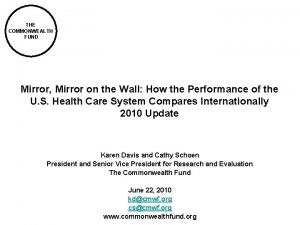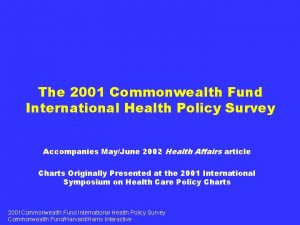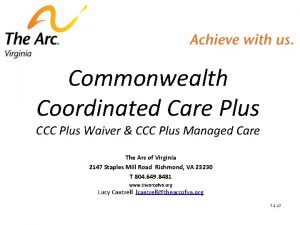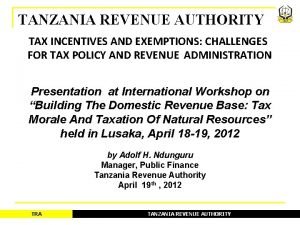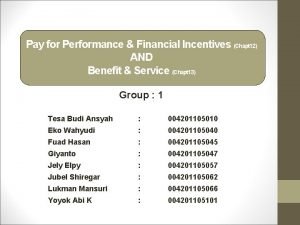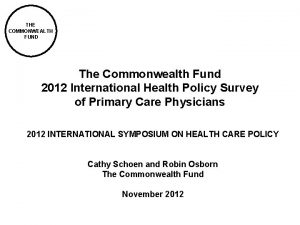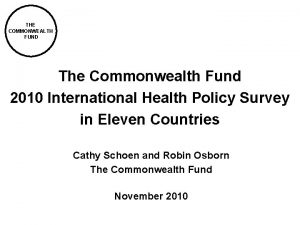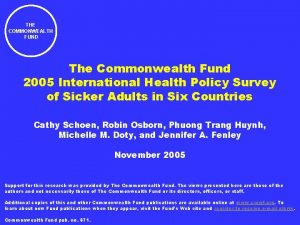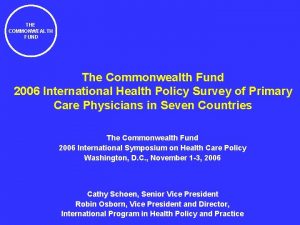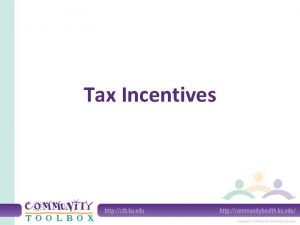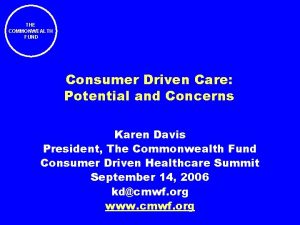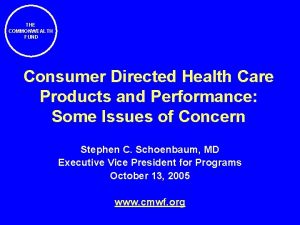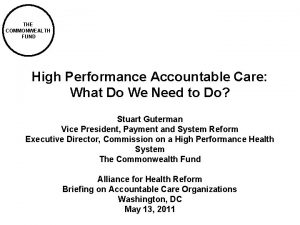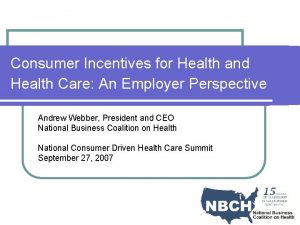THE COMMONWEALTH FUND Promoting CostEffective Care Consumer Incentives















- Slides: 15

THE COMMONWEALTH FUND Promoting Cost-Effective Care: Consumer Incentives versus “Supply Side Strategy” Karen Davis President, The Commonwealth Fund Health System Change Conference December 3, 2003

• • • Employer Health Benefit Design From an Economic Perspective 2 If employers shift health insurance costs backward onto employees, rising costs don’t affect employers – Employers should be largely indifferent to extent of employee costsharing for benefits or employee share of premium – Employers should simply act as employees’ agent in obtaining the mix of health benefits and wages desired by employees – Employee can receive more in wages and less in health benefits or more in health benefits and less in wages In such a world, total labor compensation is largely affected by productivity growth, e. g. if total compensation goes up 3% and health benefits are 15% of total compensation, and projected to rise by 12% in coming year, employer could offer: • 12% increase in health cost, 1. 4% increase in wages • 10% increase in health cost, 1. 8% increase in wages, or • 0% increase in health costs, 3. 5% increase in wages – Employer should simply ascertain which is most preferred by employees In real world, unlikely that backward shifting occurs perfectly or quickly – Employers want to obtain value for health benefit dollars – Society wants resources used efficiently – Equitable access to care for low-wage workers and equitable THE COMMONWEALTH distribution of financial burden are important FUND – Quality of care is important – e. g. no underuse or overuse or misuse

3 Cost-Sharing from Consumer Perspective • Cost-sharing in the U. S. is already high • Cost-sharing creates a burden on low-income and sick • Health care costs concentrated in sick few • Cost-sharing leads to underuse of appropriate care • Consumers rarely have the information to make choices based on quality and efficiency • Promoting cost-effective care directly by working on the supply side is a better strategy, e. g. – Research on cost-effective care – Clinical guidelines, quality standards – Public data on quality and efficiency – Financial rewards to providers for high quality, efficient care THE COMMONWEALTH FUND

4 HSC Issue Brief on Cost-Sharing • Important contribution • Shows higher cost-sharing falls disproportionately on low-income and sick • Most important finding is percent of population who are underinsured (i. e. , at risk of spending more than 10% of income on health care if become seriously ill) under various cost-sharing scenarios • If focus on hospitalized patients – which could happen to anyone – 2 -7% underinsured under modest copayments, 20% under cost-sharing in typical employer plans currently, 32% in a $1000 deductible plan similar to Health Savings Account legislation, and 66% under a $2500 deductible plan • Trend toward higher cost-sharing will increase numbers of underinsured THE COMMONWEALTH FUND

5 U. S. Patient Cost-Sharing is Highest Per Capita Out-of-Pocket Health Care Spending in Selected Countries, 2000 Dollars a b a c 1999, b 1998, c 1996 Source: Anderson et al. , Multinational Comparisons of Health Systems Data, 2002. The Commonwealth Fund, October 2002. a THE COMMONWEALTH FUND

Cost-Sharing Blunt Instrument for Affecting Use of Appropriate Care 6 • Mc. Glynn NJEM June 2003 study finds that only 55% get indicated care – About 100 million Americans underuse care – About 30 million Americans overuse care • Increased cost-sharing will reduce overuse but will also increase the extent of underuse • Rand Health Insurance Experiment demonstrated this • More recent study in Canada with increased costsharing demonstrates that • NEJM December 4, 2003 study indicated prescription drug cost-sharing leads not to filling needed prescriptions • Most costs are concentrated in very sick few who have little control over decision-making for their own care, e. g. heart attack, stroke, trauma patients • High deductible plans not the way to control cost of high-cost cases THE COMMONWEALTH FUND

Cost Sharing Reduces Likelihood of Receiving Effective Medical Care 7 Percent* In Cost-Sharing Plans * Probability of receiving highly effective care for acute conditions that is appropriate and necessary compared to those with no cost-sharing Source: K. N. Lohr et al. , Use of Medical Care in the RAND HIE. Medical Care 24, supplement 9 (1986): S 1 -87. THE COMMONWEALTH FUND

8 Cost Sharing Reduces Both Appropriate and Inappropriate Hospital Admissions Percent reduction in number of hospital admissions per 1000 person-years *Based on Appropriateness Evaluation Protocol (AEP) instrument developed by Boston University researchers in consultation with Massachusetts physicians Source: A. L. Siu et al. , “Inappropriate Use of Hospitals in a Randomized Trial of Health Insurance Plans, ” New England Journal of Medicine 315, no. 20 (1986): 1259– 1266. THE COMMONWEALTH FUND

Cost Sharing Reduces Use of Both Essential and Less Essential Drugs and Increases Risk of Adverse Events Percent reduction in drugs per day 9 Percent increase in incidence per 10, 000 Source: R. Tamblyn et al. , “Adverse Events Associated With Prescription Drug Cost. Sharing Among Poor and Elderly Person, ” JAMA 285, no. 4 (2001): 421– 429. THE COMMONWEALTH FUND

Health Care Costs Concentrated in Sick Few 10 Distribution of Health Expenditures for the U. S. Population, By Magnitude of Expenditure, 1997 Expenditure Threshold (1997 Dollars) 1% 5% 10% 50% 27% $27, 914 55% $7, 995 69% $4, 115 97% $351 Source: A. C. Monheit, “Persistence in Health Expenditures in the Short Run: Prevalence and Consequences, ” Medical Care 41, supplement 7 (2003): III 53–III 64. THE COMMONWEALTH FUND

11 Hard to Design Cost-Sharing to Avoid its Pitfalls • Would have to vary by income and health status • Would have to vary by clinical indications for a given service, e. g. an MRI is appropriate for some conditions but not others • Patients would have to have access to information on quality that they do not now have • Even primary care physicians rarely have access to quality information on the specialists to whom they refer patients • Physicians are resistant to having quality data available • Would have to change patient-physician relationship with more control over decision-making by patients • Plans could create networks of high quality, efficient providers – Although their access to quality data and riskadjusted longitudinal cost data are also limited THE COMMONWEALTH FUND

12 There is a Better Way: Walking on the Supply Side • A “supply side” strategy to promoting cost effective care shows more promise than increased patient cost-sharing • Instead of cost-sharing for ER use, nurse call banks are used by Partners Health Care to call patients with frequent use of ERs, screen for depression, medication compliance • Instead of cost-sharing for tests, Intermountain Health. Care puts clinical criteria for ordering tests before the ordering physicians • Instead of tiered cost-sharing for hospital care, University of Pennsylvania Hospital uses advanced practice nurses to work with high-risk hospitalized patients and reduce rehospitalization THE COMMONWEALTH FUND

Effect of Advanced Practice Nurse Care on Congestive Heart Failure Patients’ Average Per Capita Expenditures 13 Dollars 9, 618 6, 152 Source: M. D. Naylor, “Making the Business Case for the APN Care Model, ” report to the Commonwealth Fund, October 2003; estimated charges by Mark Pauly. THE COMMONWEALTH FUND

Achieving a High Performance Health System: What it Requires 14 • Expansion of government’s role: – In setting quality standards/clinical guidelines on effective care – Supporting research on cost-effective care and costeffectiveness of quality improvement interventions – Requiring public release of quality and efficiency data – Paying for performance within public programs (especially Medicare and Medicaid) • Public-private partnership: – Engage entire health care system in continuous quality improvement – Develop and disseminate quality improvement tools – Identify and spread best practices – Encourage learning collaboratives to improve care – Promote modern information technology – Reward quality and efficiency • Automatic and affordable health insurance for all THE COMMONWEALTH FUND

Acknowledgements 15 Stephen C. Schoenbaum, Senior Vice President, Commonwealth Fund; Stephen C. Schoenbaum, Anne-Marie J. Audet, and Karen Davis, “Obtaining Greater Value From Health Care: The Roles of the U. S. Government, ” Health Affairs, Nov/Dec 2003. Barbara Cooper, Senior Program Officer, Commonwealth Fund; Karen Davis and Barbara Cooper, American Health Care: Why So Costly, Commonwealth Fund, June 2003 Senate Testimony. Research assistance – Alice Ho, Research Associate, Commonwealth Fund Karen Davis, Achieving a High Performance Health System, Commonwealth Fund, forthcoming publication January 2004. THE COMMONWEALTH FUND Visit the Fund at: www. cmwf. org
 Clouds in the sky
Clouds in the sky Mirror mirror commonwealth fund
Mirror mirror commonwealth fund Commonwealth fund international health policy survey
Commonwealth fund international health policy survey Promoting excellence in dementia care
Promoting excellence in dementia care Commonwealth coordinated care
Commonwealth coordinated care Fluctuating petty cash system
Fluctuating petty cash system Primary secondary tertiary medical care
Primary secondary tertiary medical care Is a greenfly a herbivore
Is a greenfly a herbivore Cengage
Cengage Consumer behaviour research process
Consumer behaviour research process Chapter 5 consumer markets and buyer behavior
Chapter 5 consumer markets and buyer behavior Types of buyer behavior
Types of buyer behavior Tax incentives in tanzania
Tax incentives in tanzania Sales promotion
Sales promotion Fiscal incentives for industrial promotion (revised)-2013
Fiscal incentives for industrial promotion (revised)-2013 Financial incentives adalah
Financial incentives adalah

